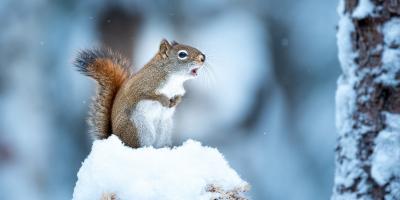Gray Squirrel vs. Red Squirrel: The Difference Is More Than Fur-Deep

New England is home to a wide array of wildlife, but few species are as cute, populous or—if you’re a farmer—as aggravating as gray and red squirrels. Squirrel populations have exploded in the northeast in recent years. Just last year, a massive bumper crop of squirrels ate their way across pumpkin fields and apple orchards from Vermont to Maine. Most people probably think they can easily tell the difference between gray and red squirrels—after all, they’re named based on their color, right?
Turns out, the differences between red and gray squirrels go way past just their fur color.
How to Spot Gray vs. Red Squirrels
Rather than rely strictly on color, an easier way to distinguish gray vs. red squirrels is by their relative sizes: red squirrels are distinctively smaller than their gray brethren, about half the larger squirrels’ size, actually.
But what red squirrels don’t have in terms of brawn they make up for in bite. Red squirrels are notoriously more aggressive than the far more docile gray variety; some of whom can sometimes almost seem shy. That’s not to say, however, that red squirrels are more active than gray ones, as both are quite the busybodies, with neither variety slowing down to hibernate during the winter.
A Smarter Shade?
Recent research has confirmed another difference that squirrel watchers have long suspected: Gray squirrels are actually more intelligent than red squirrels. Since both species share similar resources—both nest in fallen trees and eat the same variety of nuts and vegetables, for example—the slower, more skittish gray squirrel had to develop an edge against its feisty red counterpart. It did so, ironically enough, by growing its gray matter. Gray squirrels’ superior craftiness help them to outcompete their ruddy cousins, thus securing their fair share of the available food and shelter.
This has made gray squirrels especially problematic not just for farmers, but for homeowners as well. Gray squirrels have become quite adept at problem-solving their way into warm homes during the colder winter months by finding or making small holes just big enough to squeeze through, then building nests in attics and insulation.
Smart Move: Steer Clear of Gray and Red Squirrels
Whether you’re talking about red squirrels or gray squirrels, the most important trait they share is that—no matter how cute and cuddly they may seem—they both pose a potential health risk to human beings. Not only are they vectors for disease, their nests can become overrun with urine and feces, which can be toxic to humans.
If you happen to find a den of squirrels cozied up in your home—most often in the attic—the best way to deal with them is a humane but effective squirrel exclusion service performed by a wildlife control expert. Stay tuned for our upcoming blog post, “The Key to Humane Squirrel Exclusion: Preparation,” which will go over everything you’ll want to know about the subject.
Can’t wait that long? Visit our page on squirrel control to request a free on-site consultation with a wildlife professional.



